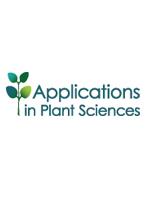Bidens alba (L.) DC. (Asteraceae) is a cosmopolitan subtropical and tropical weed that is native to North and Central America (Ballard, 1986) and has recently become invasive in China. Bidens alba reproduces vigorously and has been rapidly spreading in southern China. It grows along roadsides and in abandoned farmland and orchards, resulting in a decline in soil fertility and crop production (Tian et al., 2010). Bidens alba is a tetraploid species (2n = 48) (Grombone-Guaratini et al., 2005; Knope et al., 2013). Currently, no microsatellite markers are available for population genetic studies of B. alba. In this study, we isolated and characterized 20 polymorphic microsatellites for B. alba, which can be used to assess its genetic variation within and among populations and track its invasion route in China.
METHODS AND RESULTS
Genomic DNA was extracted from silica gel-dried leaves using a modified cetyltrimethylammonium bromide (CTAB) method (Doyle and Doyle, 1987). Genomic DNA from 20 individuals was mixed and sequenced using commercial services provided by Sangon Biotech (Shanghai, China) using 454 GS FLX Titanium (454 Life Sciences, a Roche Company, Branford, Connecticut, USA). A total of 149,204 reads with an average length of 423 bp were obtained, and a total of 11,049 reads contained microsatellite motifs. One hundred and twenty-eight primer pairs from B. alba designed by Primer Premier 6.0 (Premier Biosoft International, Palo Alto, California, USA) were tested in 10 individuals as preparatory screening. Primers that produced reproducible and clearly defined bands were further tested for polymorphism in one B. alba population (30 individuals; 23.41505°N, 111.24734°E) and one population of the closely related B. pilosa L. (30 individuals; 25.26276°N, 111.32731°E). Voucher specimens (S. Tang 20121001 for B. alba and S. Tang 20120701 for B. pilosa) were deposited at the herbarium of Guangxi Normal University. PCRs were performed in 20-µL reaction volumes containing 1 unit of Taq polymerase (TaKaRa Biotechnology Co., Dalian, China), 2 µL of 10× PCR buffer, 0.4 µL of dNTPs (2.5 mM), 0.2 µL of each primer (50 µM), and 40 ng of genomic DNA. PCR amplification conditions were as follows: an initial denaturation at 94°C for 5 min, 30 cycles of 45 s at 94°C, 45 s at the optimized annealing temperature (Table 1), 45 s of extension at 70°C, ending with a 10-min extension at 72°C. PCR products were resolved on a 6% Polyacrylamide denaturing gel using a 10-bp DNA ladder (Invitrogen, Carlsbad, California, USA) as the reference and visualized by silver staining.
In total, 20 highly polymorphic primer pairs were successfully amplified with expected sizes. These loci showed clearly defined banding patterns ranging from one to four alleles for each locus per individual. The expected heterozygosity (He) and the Shannon–Wiener index (H') were calculated with ATETRA version 1.2 a (Van Puyvelde et al., 2010), which includes all possible combinations of allele copy numbers in populations with partial heterozygotes.
As a result, all of the 20 microsatellite loci were polymorphic in B. alba and the number of alleles per locus varied from three to 32 alleles, with a mean of 13.4. He and H' were between 0.3787 and 0.9284 (mean = 0.7755) and 0.6796 to 2.8401 (mean = 1.8064), respectively. In B. pilosa, six loci were monomorphc. The number of alleles (A) per locus varied from one to 14, He varied from 0 to 0.8380, and H' ranged from 0 to 2.0937 (Table 2).
CONCLUSIONS
The 20 microsatellite loci developed for B. alba are useful for investigating the genetic structure, genetic diversity, and invasion dynamics of B. alba. Some of these loci will also be useful for B. pilosa.
Table 1.
Characteristics of 20 polymorphic microsatellite markers in Bidens alba.

Table 2.
Results of marker screening in Bidens alba and B. pilosa.






